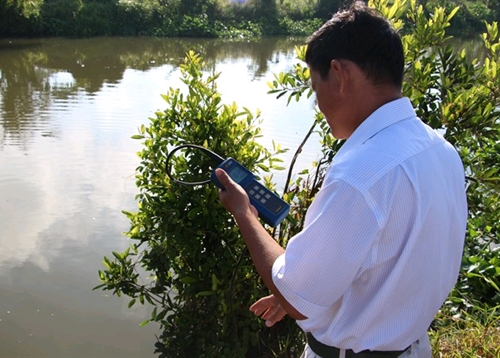In Ben Tre, the first province to be affected, saltwater intrusion began in mid-February.
Saltwater has entered up to 50km deep inland into canals in rice fields in Ben Tre. In Ba Tri district, the salt content rate of water in canals in rice fields has reached 0.1 – 0.15 percent.
The salt content rate could affect 11,000ha of winter–spring rice in the district, according to the district’s Agriculture and Rural Development Division.
Local residents in the province’s coastal areas have to store fresh water in ponds and containers for household use and agricultural production.
    |
 |
|
An official checks the salt content of water in Hau Giang province’s Vi Thanh district. |
Nguyen Thi Hang of Ben Tre’s Giong Trom district said after the impact of saltwater intrusion in 2015, her family built water containers with a total capacity of 15cu.m to store rainwater in the dry season.
The southern region has entered the dry season, with the peak hot weather occurring between March and May.
This year saltwater intrusion is expected to be more serious than last year and the salt content higher as well, according to the National Center for Hydro-Meteorology Forecasting.
Le Van Hung, head of the Dong Thap province Sub-department of Irrigation, said the dry season came earlier this year and the water levels of rivers had declined to 0.1 – 0.3 meter lower than normal.
These factors would cause serious drought, especially in May. The end of the winter- spring crop and the beginning of the summer – autumn crop would be affected, he said.
The province’s Northern districts of Hong Ngu, Tan Hong, Tam Nong and Thanh Binh and Hpng Ngu town would be the most affected, he said.
In Hau Giang province, about 40,000 to 50,000ha of winter – spring rice and summer – autumn rice will be hit by saltwater intrusion, according to the province’s Department of Agriculture and Rural Development.
Sluice gates on rivers where the content of salinity in water is high have been closed.
Tran Chi Hung, director of Hậu Giang Province’s Department of Agriculture and Rural Development, said the department had warned residents to prepare equipment to store water for daily use, consolidate embankments and dredge ponds to store water.
“Farmers should regularly visit their rice fields and watch news about saltwater intrusion,” he said.
Hau Giang has spent VND 67.5 billion (USD 2.9 million) on building 120 temporary dams and sluices and dredge 71 canals.
Earlier this year, authorities in the delta, which includes 12 provinces and Can Tho city, took many measures to prevent saltwater intrusion and drought in the dry season.
The localities have built temporary dams to prevent saltwater intrusion and dredged canals to have water for agricultural production. They have also encouraged farmers in saltwater affected areas to switch to other crops.
To deal with the delta’s annual saltwater intrusion, many coastal areas in the delta are growing rice varieties that are highly resistant to saltwater intrusion.
In Ca Mau province’s Cai Nuoc district, farmers are planting two new rice varieties – Ca Mau 1 and Ca Mau 2 - in the ongoing winter-spring rice crop.
The varieties, which can resist saltwater with a salt content of 1.2 percent, have soft and fragrant characteristics.
Doan Van Chinh, deputy head of the district’s Agriculture and Rural Development Division, said the district was planting the two rice varieties on a total area of about 100ha and would later plant them on a large scale in Phu Hung and Thanh Phu communes.
In Bac Lieu province, farmers are planting Soi and Mot Bui Do saltwater-resistant rice varieties in Hong Dan district.
Soi rice grows in water with a salt content of 0.9 – 1 percent and has a yield of 6 tonnes per ha. The rice variety is also disease resistant and quality meets export standards.
In the delta, farmers in coastal areas are also planting rice in the rainy season and breeding shrimp, fish or other aquatic species in the dry season on the same field.
The rotation model, which offers high profits for farmers, has adapted well to climate change in the delta coastal areas, according to authorities.
Source: VNS/VNA